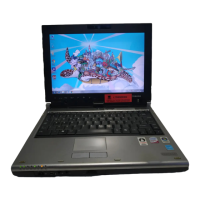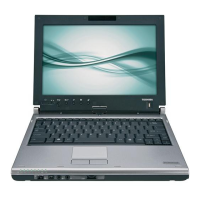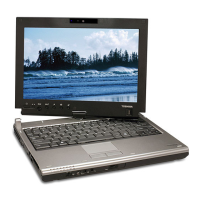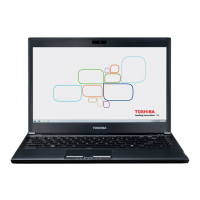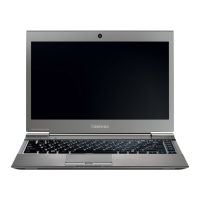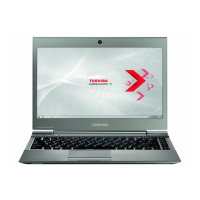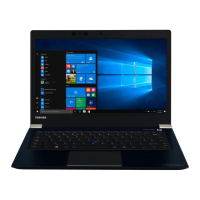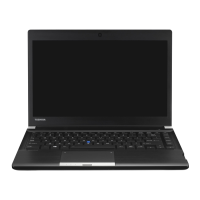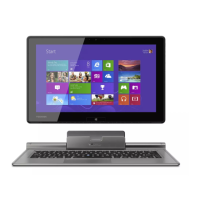
Do you have a question about the Toshiba PORTEGE M800 and is the answer not in the manual?
| Bus type | FSB |
|---|---|
| Stepping | R0 |
| Tjunction | 105 °C |
| Processor cache | 3 MB |
| Processor cores | 2 |
| Processor model | P8700 |
| Processor family | Intel® Core™2 Duo |
| Processor series | Intel Core 2 Duo P8000 Series |
| Processor socket | Socket 479 |
| Processor codename | Penryn |
| Processing Die size | 107 mm² |
| Processor frequency | 2.53 GHz |
| Processor cache type | L2 |
| Processor lithography | 45 nm |
| Processor manufacturer | Intel |
| Processor front side bus | 1066 MHz |
| Processor operating modes | 64-bit |
| ECC supported by processor | No |
| Thermal Design Power (TDP) | 25 W |
| CPU multiplier (bus/core ratio) | 9.5 |
| Number of Processing Die Transistors | 410 M |
| HDD speed | 5400 RPM |
| HDD interface | SATA |
| Optical drive type | DVD Super Multi DL |
| Total storage capacity | 320 GB |
| Number of HDDs installed | 1 |
| Display diagonal | 13.3 \ |
| Display resolution | 1280 x 800 pixels |
| Native aspect ratio | 16:10 |
| Internal memory | 2 GB |
| Memory clock speed | 800 MHz |
| Internal memory type | DDR2-SDRAM |
| Maximum internal memory | 4 GB |
| Memory layout (slots x size) | 1 x 2 GB |
| Type | PC |
| Internal modem | Yes |
| Wireless technology | 802.11a/g/n |
| CD-R write speed | 24 x |
| DVD+R write speed | 8 x |
| DVD-RW write speed | 4 x |
| DVD+R Double Layer write speed | 2.4 x |
| Trial software | Office |
| Operating system installed | Windows Vista Business |
| Battery life (max) | 4 h |
| Charging port type | DC-in jack |
| Serial ports quantity | 0 |
| USB 2.0 ports quantity | USB 2.0 ports have a data transmission speed of 480 Mbps, and are backwards compatible with USB 1.1 ports. You can connect all kinds of peripheral devices to them. |
| Cable lock slot type | Kensington |
| Pointing device | Touchpad |
| Keyboard number of keys | 85 |
| Discrete graphics card model | Intel GMA GM45 |
| Processor code | SLGFE |
| Processor ARK ID | 37006 |
| Processor package size | 35 x 35 mm |
| Depth | 229 mm |
|---|---|
| Width | 314 mm |
| Weight | 1900 g |
| Height (rear) | 35 mm |
| Height (front) | 27.5 mm |
Outlines the structure and components of the user manual.
Explains the formatting conventions used throughout the manual for clarity.
Lists all hardware and software items included with the computer for verification.
Details the physical components and items included in the computer package.
Lists all software applications pre-installed on the computer.
Highlights the unique and advanced features of the computer system.
Describes the computer's power sources, including battery and AC adaptor.
Details the computer's hard disk drive and optical media drive capabilities.
Explains the various input/output ports available on the computer.
Covers built-in modem and LAN capabilities for connectivity.
Details unique features that enhance computer usability and convenience.
Describes optional devices that can expand the computer's capabilities.
Identifies external components visible when the computer display is closed.
Details the ports and connectors located on the left side of the computer.
Details the ports and connectors located on the right side of the computer.
Details the ports and connectors located on the back side of the computer.
Identifies components located on the bottom of the computer.
Identifies components visible when the computer display is open.
Explains the operation and specifications of the optical disc drive.
Describes the AC adaptor used for powering and charging the computer.
Explains the functionality and use of the included remote controller.
Provides step-by-step instructions for installing the computer's battery pack.
Guides users on how to connect the AC adaptor for power and charging.
Explains the procedure for turning on the computer for the first time.
Details the initial setup process for the Windows Vista operating system.
Describes how to properly shut down, hibernate, or sleep the computer.
Explains how to use Sleep Mode for power saving and quick resume.
Explains how to use Hibernation Mode to save system state and power.
Provides methods for resetting or restarting the computer system.
Details options for repairing the system or restoring it to factory settings.
Guides on restoring software from the computer's recovery partition.
Explains how to use the computer's TouchPad for cursor control and interaction.
Details how to use the fingerprint sensor for authentication and security.
Instructs on how to insert discs into the optical drive.
Covers connecting and configuring the internal modem for communication.
Explains how to use and configure the Wireless LAN feature.
Describes the standard alphanumeric and symbol keys on the keyboard.
Explains keyboard shortcuts for quick system configuration and function access.
Describes how to make the Fn key sticky for easier access to function keys.
Explains the function of Windows-specific keys on the keyboard.
Details how to use the integrated numeric keypad overlay function.
Explains how power status affects computer operation and battery charging.
Describes the different types of batteries used in the computer.
Provides essential safety precautions and guidelines for battery pack usage.
Details the procedure for charging the computer's battery pack.
Explains how to check the remaining battery power and its status.
Offers tips and methods to extend the battery life of the computer.
Guides on how to safely remove and install the battery pack.
Explains how to enter and navigate the hardware setup utility.
Covers setting or resetting user passwords for power-on protection.
Describes how to configure the computer's boot sequence.
Details keyboard-related settings within the HW Setup utility.
Explains the ExpressCard slot and how to insert/remove cards.
Details the types of memory cards supported by the computer.
Guides on installing additional RAM modules to increase memory.
Explains how to connect an external monitor to the computer.
Details how to connect external devices using the HDMI port.
Covers high-speed data transfer using the i.LINK port.
Explains how to connect external storage devices via eSATA.
Describes how to use a security lock to protect the computer from theft.
Outlines a systematic approach to diagnosing and resolving computer problems.
Provides a list of simple checks to perform before deeper troubleshooting.
Offers checks for common hardware and system-related issues.
Explains the automatic self-test performed by the computer at startup.
Troubleshooting steps related to AC adaptor and power supply issues.
Troubleshooting steps related to battery performance and charging issues.
Addresses common problems encountered with the computer's keyboard.
Troubleshooting steps for issues related to the computer's display screen.
Troubleshooting steps for problems with the computer's hard disk drive.
Provides solutions for common problems with the computer's modem.
Troubleshooting steps for issues related to Wireless LAN connectivity.
Addresses problems related to the fingerprint sensor's recognition and functionality.
Lists the environmental conditions for operating and storing the computer.
Details the electrical specifications for the AC adaptor and computer.
Provides technical details about the computer's built-in modem.
Explains the function and capabilities of the computer's display controller.
Details the technical specifications of the wireless LAN card.
Describes the radio frequency and modulation characteristics of wireless communication.
Lists the certification agencies for AC power cords in various regions.
Discusses factors affecting CPU performance and legal footnotes.
Explains how battery life varies and factors influencing it.
Provides a list of abbreviations used throughout the manual with their definitions.


